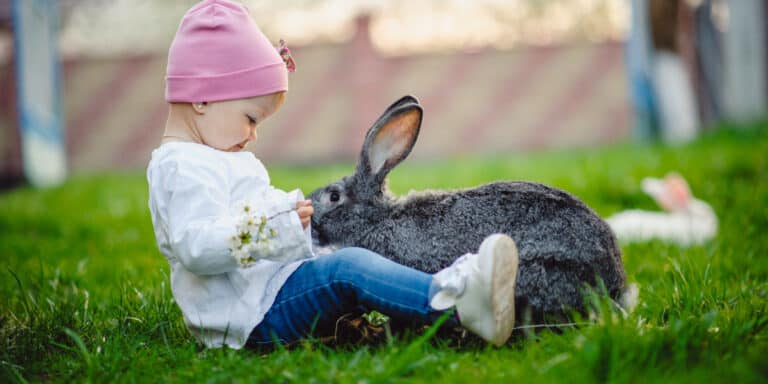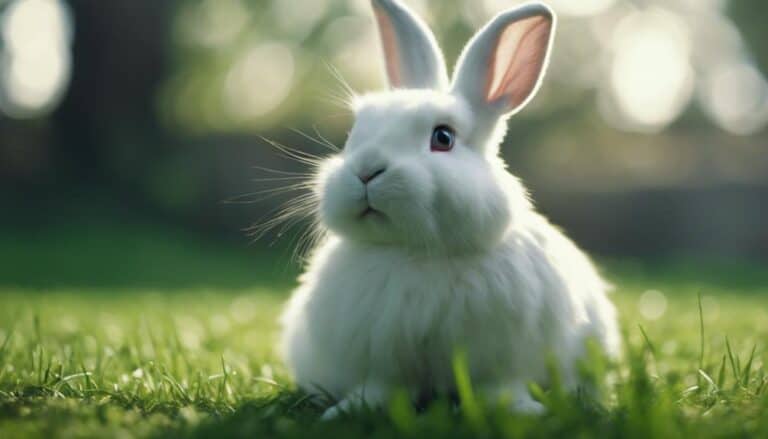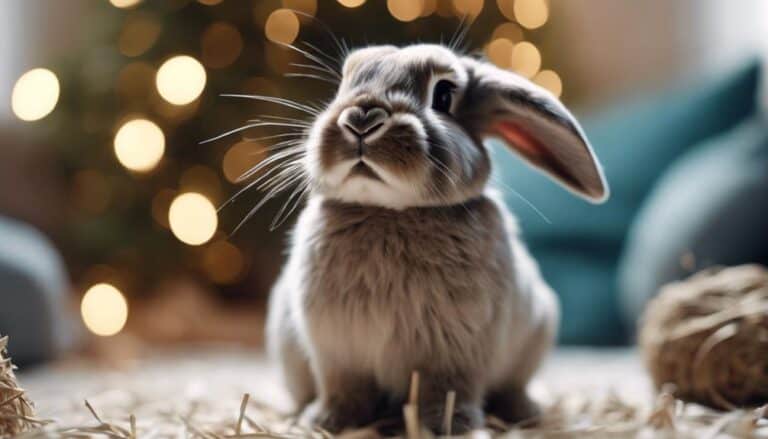Explore the secrets behind bunny bonding behaviors in a way that will reshape your understanding of these fluffy companions. Discover how seemingly simple actions like grooming and playing hold intricate meanings in the domain of rabbit relationships.
Unravel the complexities of dominance dynamics and conflict resolution that govern their social interactions, offering a glimpse into the fascinating world of bunny communication and companionship.
Delve into the nuances of bunny body language and the subtle cues that hold the key to fostering strong and lasting bonds between these adorable creatures.
Contents
- 1 Key Takeaways
- 2 Understanding Bunny Body Language
- 3 Establishing Dominance in Bunny Pairs
- 4 Importance of Grooming in Bonding
- 5 Communication Through Bunny Sounds
- 6 The Role of Play in Bonding
- 7 Signs of Stress in Bonding Bunnies
- 8 Successful Bunny Bonding Tips
- 9 Frequently Asked Questions
- 10 Is Fighting a Normal Part of Bunny Bonding Behavior?
- 11 Conclusion
Key Takeaways
- Understanding bunny communication cues like ear position and tail movements is crucial for successful bonding.
- Recognizing dominance behaviors such as humping helps establish hierarchy and prevent conflicts in bunny pairs.
- Grooming plays a vital role in bonding, fostering trust and strengthening the relationship between rabbits.
- Incorporating playful activities like chasing and binkying aids in reducing stress and building a strong bond between bunnies.
Understanding Bunny Body Language
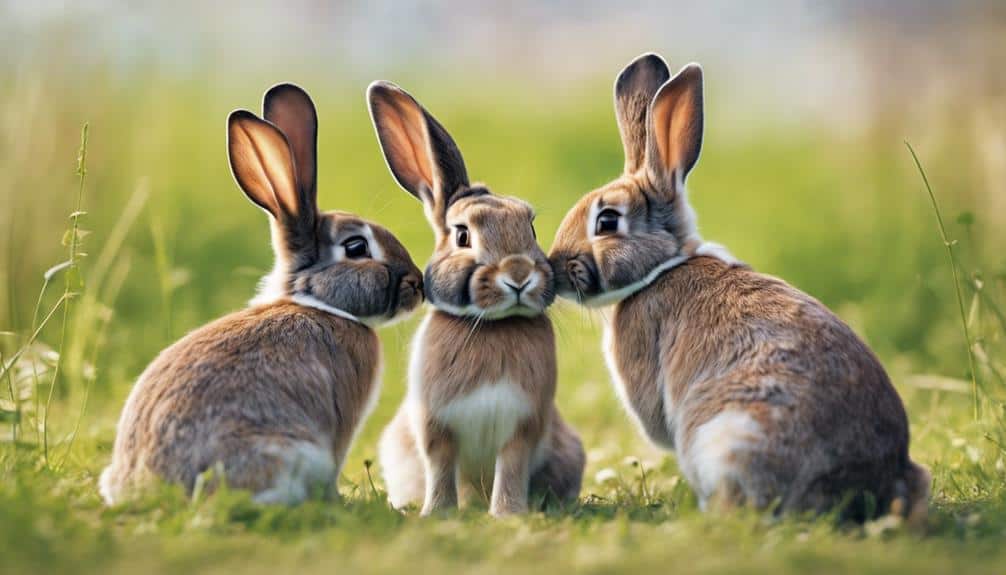
Understanding bunny body language is essential for interpreting your rabbit's feelings and intentions accurately. Rabbit body language, including ear position, tail movement, and body posture, serves as a critical form of communication.
When a rabbit holds its ears tightly back, it may indicate fear or aggression, highlighting the importance of paying attention to ear movements. Conversely, a relaxed rabbit will have ears held loosely and exhibit a calm body posture, signaling relaxation and contentment.
Tail twitching or thumping can convey feelings of irritation or agitation in rabbits, providing insights into their emotional state.
Establishing Dominance in Bunny Pairs
To establish dominance in bunny pairs, observing behaviors like humping is essential for determining hierarchy and preventing conflicts within the bond. Humping, a common dominance behavior, should be allowed to happen as soon as the bunnies start bonding. This behavior might seem aggressive, but it's important for them to establish their roles early on.
While humping may be lasting, setting boundaries around this behavior is necessary to guarantee that it doesn't escalate into aggression or cause distress. By understanding dominance behaviors like humping and respecting their significance, you can pave the way for successful bonding between your bunny pairs.
Importance of Grooming in Bonding
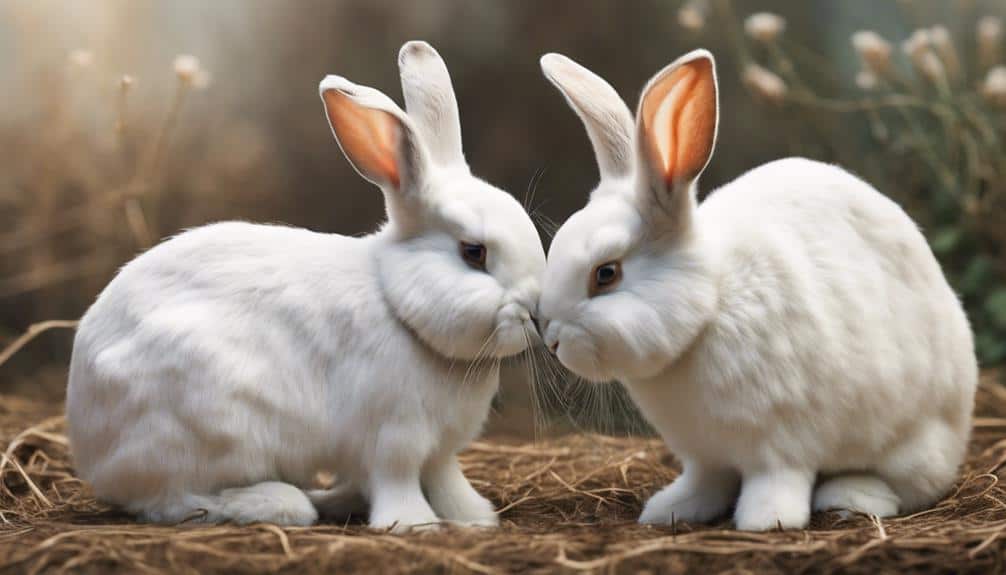
Grooming plays a pivotal role in fostering trust and strengthening the bond between rabbits. This bonding behavior isn't just about cleanliness; it's a fundamental aspect of their social interactions.
When rabbits engage in mutual grooming, they release oxytocin, often referred to as the bonding hormone. This hormone promotes closeness and helps deepen the relationship between bonded pairs. Additionally, grooming serves as a stress-reliever, reducing anxiety and creating a positive association between the rabbits.
By grooming each other, rabbits maintain their social bonds and reinforce their relationship. It's essential to pay attention to grooming dynamics, as a lack of grooming or rejection of grooming can signal potential issues in the bonding process that require intervention.
Ensuring that rabbits have the opportunity to groom each other is vital for building a strong and trusting bond between them.
Communication Through Bunny Sounds
Bonding behaviors in rabbits extend beyond grooming, as they also utilize a diverse range of sounds to communicate various emotions and messages to one another. Rabbits have a complex language of sounds that convey different meanings:
- Purring: This sound indicates contentment or pleasure in rabbits, often heard during bonding sessions where they feel safe and happy.
- Grunting: Rabbits grunt to express annoyance or displeasure, especially during interactions with other rabbits that may be perceived as threatening or invasive.
- Honking: When rabbits are excited or happy, they emit a honking sound, which is commonly heard during play or bonding moments.
Understanding these sounds is essential for interpreting your rabbits' feelings and maintaining a harmonious bond. It's important to pay attention to the context in which these sounds are made, as they can reveal important information about your rabbits' well-being and emotional state. Remember, proper communication through sounds can strengthen the bond between you and your rabbits.
The Role of Play in Bonding
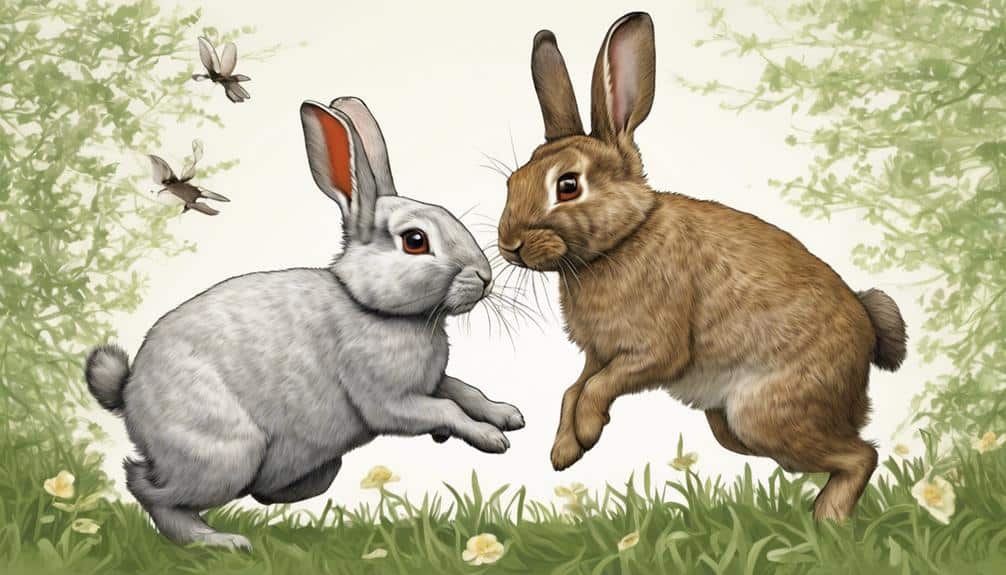
Playing is a critical component when it comes to rabbit bonding.
Rabbits use playful activities such as chasing, hopping, and binkying to establish trust and enhance communication.
It's through play that rabbits reduce stress, fostering a positive environment that aids in their bonding process.
Importance of Play
Engaging in playful activities with your rabbits is an essential component in fostering a strong and trusting bond between them. Play serves as a bonding behavior that helps build trust and establish a positive relationship.
Here are three key points to emphasize the importance of play in strengthening the bond between your rabbits:
- Playful interactions create shared experiences, promoting a deeper connection.
- Play helps reduce stress and tension among rabbits, making the bonding process smoother.
- Incorporating toys and tunnels into their playtime can enhance the bonding experience and strengthen their bond.
Playful Interactions Strengthen
To strengthen the bond between your rabbits, it's imperative to recognize how playful interactions serve as a fundamental aspect of fostering trust and connection. Playful interactions, such as mutual grooming, play fighting, binkying, and exploring together, play a crucial role in bonding.
Mutual grooming, in particular, promotes social cohesion and strengthens the bond between rabbits. Engaging in these activities not only reduces stress but also allows rabbits to communicate effectively, build rapport, and establish companionship.
Recognizing the significance of play in strengthening the bond between your rabbits is key to fostering a positive relationship. By encouraging and observing these playful interactions, you can create a harmonious environment for your rabbits to develop trust and a lasting bond.
Play as Bonding Tool
When considering the role of play in bonding between rabbits, it becomes evident that playful interactions serve as an essential tool for establishing trust and fostering social connections. Play behavior, such as chasing, grooming, and hopping around, plays a significant role in promoting bonding behaviors among rabbits.
Engaging in playful activities can effectively reduce tension and aggression during the bonding process. It's vital to monitor play sessions to make sure that both rabbits are enjoying and benefiting from the interaction.
Ultimately, these playful interactions contribute to enhancing the bond between rabbits, leading to a stronger relationship over time.
- Play behavior promotes bonding behaviors
- Monitoring ensures enjoyable and beneficial play sessions
- Playful interactions lead to a stronger relationship
Signs of Stress in Bonding Bunnies
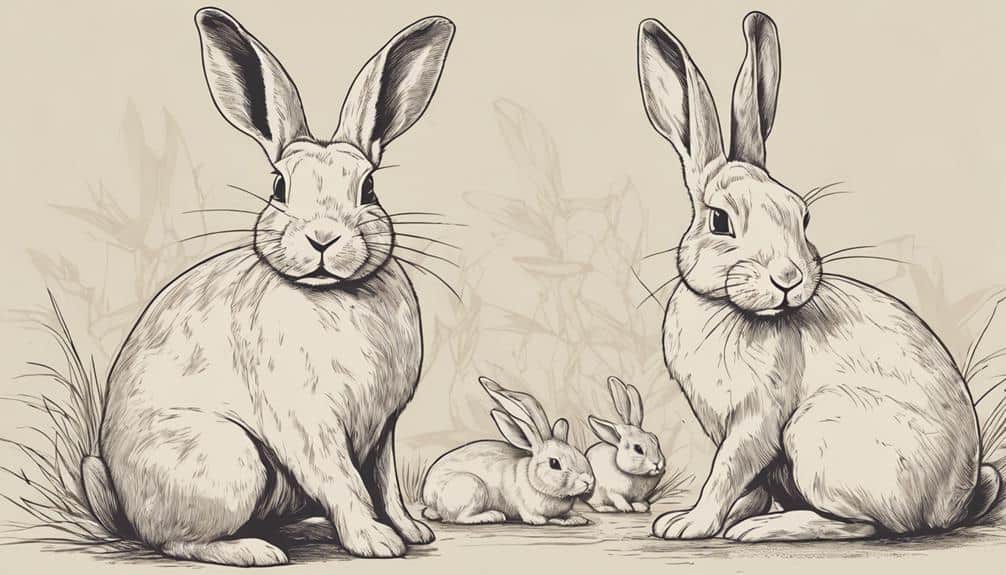
When bonding bunnies, it's important to pay attention to signs of stress. Behaviors like thumping, crouching, or avoidance may indicate that your rabbits are feeling uneasy.
Keep an eye out for communication cues and behavioral indicators that could suggest stress during the bonding process.
Stress Indicators: Bonding Bunnies
Signs of stress in bonding bunnies manifest through various behavioral and physical cues, including fur loss, decreased appetite, and increased hiding. When observing your bunnies during bonding sessions, be mindful of these indicators:
- Excessive grooming or over-grooming
- Teeth grinding, thumping, or refusing to eat
- Aggression, such as lunging or biting
Understanding these signs can help you intervene if your bunnies are experiencing stress while bonding. By being attentive to their body language, like tense posture or pinned-back ears, you can address any issues promptly. Remember, recognizing and responding to stress indicators is vital for creating a harmonious bond between your rabbits.
Behavioral Cues: Bunny Stress
To understand the behavioral cues indicating stress in bonding bunnies, observe for thumping, hiding, teeth grinding, or fur loss. Stress signs in bonding bunnies can also manifest as refusal to eat, excessive grooming, and decreased activity levels.
Keep an eye out for behavioral changes like aggression, lunging, or avoidance of their partner, as these indicate stress. This is important to note that stress in bonding bunnies can lead to health issues such as gastrointestinal stasis or fur matted with urine.
Communication Clues: Bonding Rabbits
Understanding the communication clues exhibited by bonding rabbits is essential for identifying signs of stress in these interactions. When observing bonding rabbits, pay close attention to their behaviors, as these can indicate stress levels and potential issues in the bonding process. To recognize stress signs in bonding bunnies, look for the following:
- Humping Behavior: Excessive humping can be a sign of dominance establishment or stress.
- Aggressive Behavior: Any form of aggression, such as lunging or fur-pulling, may signal stress during bonding.
- Rabbit Communication: Rabbits communicate through body language; understanding their cues is vital for managing stress and fostering a successful bond.
Successful Bunny Bonding Tips
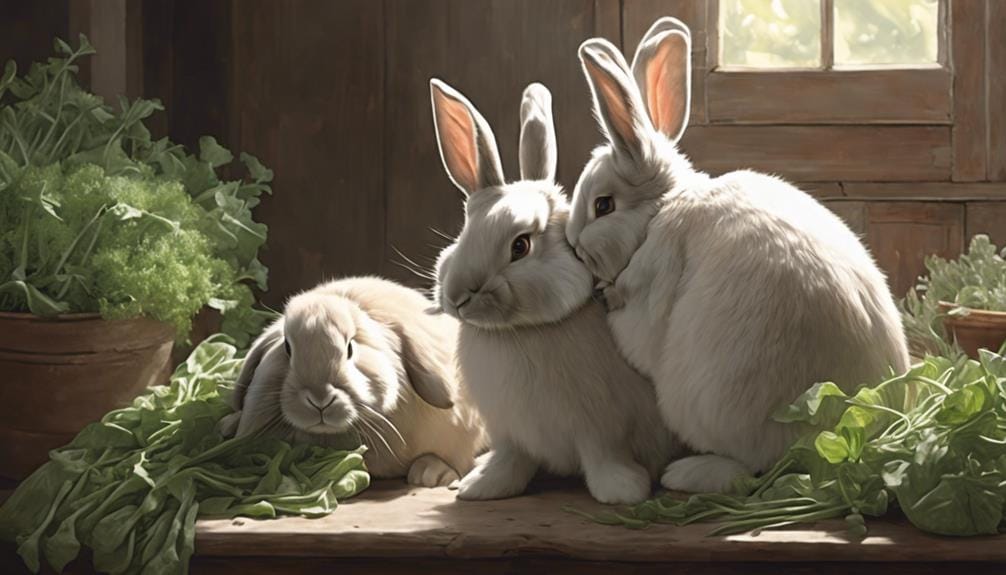
For successful bunny bonding, establishing clear boundaries around humping behavior is important to avoid potential bonding issues. Allowing humping is a natural part of rabbits establishing dominance and hierarchy during the bonding process. However, it's essential to set rules to manage this behavior and prevent it from escalating into fights or territorial disputes.
Additionally, recognizing and managing chasing behaviors between bonded rabbits is vital to prevent frustration and potential aggression. Immediate intervention during fights is necessary to prevent injuries and guarantee a successful bonding experience.
Frequently Asked Questions
What Is a Rabbit's Behavior When Bonding?
When bonding, a rabbit's behavior includes communication cues, social grooming, playtime antics, territorial disputes, establishing dominance hierarchy, using body language, mutual grooming, following bonding rituals, sharing space, and establishing trust. Understanding these behaviors is essential.
How Do You Tell if Your Bunnies Are Bonded?
To tell if your bunnies are bonded, watch for bonding signs like mutual grooming and shared space. Pay attention to body language, playful interactions, and communication cues. These indicate mutual trust, strong pair dynamics, and happy bunnies.
What Happens if You Separate Bonded Rabbits?
When you separate bonded rabbits, it can cause emotional distress, disrupt their hierarchy, and lead to behavioral changes like aggression or decreased appetite. Re-bonding may take time and patience, impacting their overall well-being.
What Is 24 7 Rabbit Bonding?
In 24/7 rabbit bonding, your bunnies enjoy constant companionship, round-the-clock bonding, and non-stop snuggling. They are always together, never apart, cuddling 24/7, sharing endless affection. This method fosters full-time friendship, forever friends, and continuous closeness.
Is Fighting a Normal Part of Bunny Bonding Behavior?
Fighting is a normal part of bunnies and bonding fights. Rabbits establish hierarchy through scuffles, which can include chasing, nipping, and mounting. It’s important to supervise them and intervene if the fights become too intense. This behavior is natural and can lead to a stronger bond once they establish their pecking order.
Conclusion
Deciphering the secrets of bunny bonding behaviors is akin to deciphering a intricate code, each action and reaction a piece of the puzzle. By understanding their body language, establishing dominance, and fostering communication through grooming and play, you can create a harmonious relationship between your bunnies.
Like cracking a code, patience, observation, and knowledge are key to deciphering the door to a strong and lasting bond between your furry companions.

